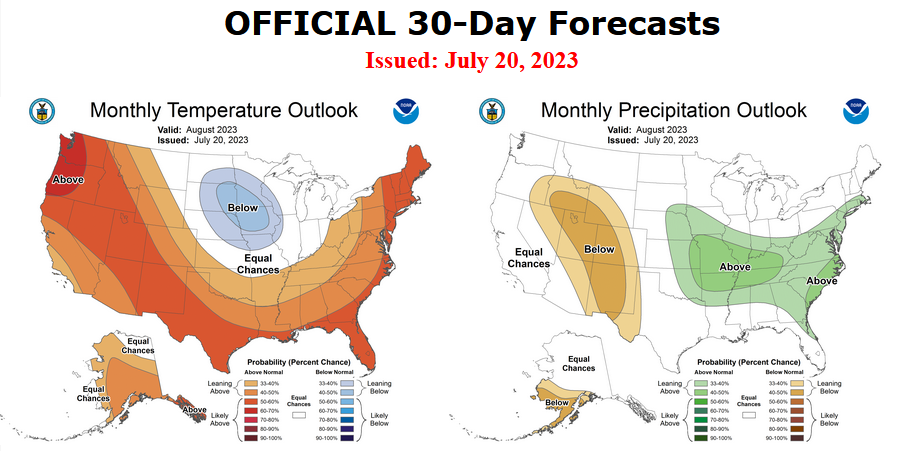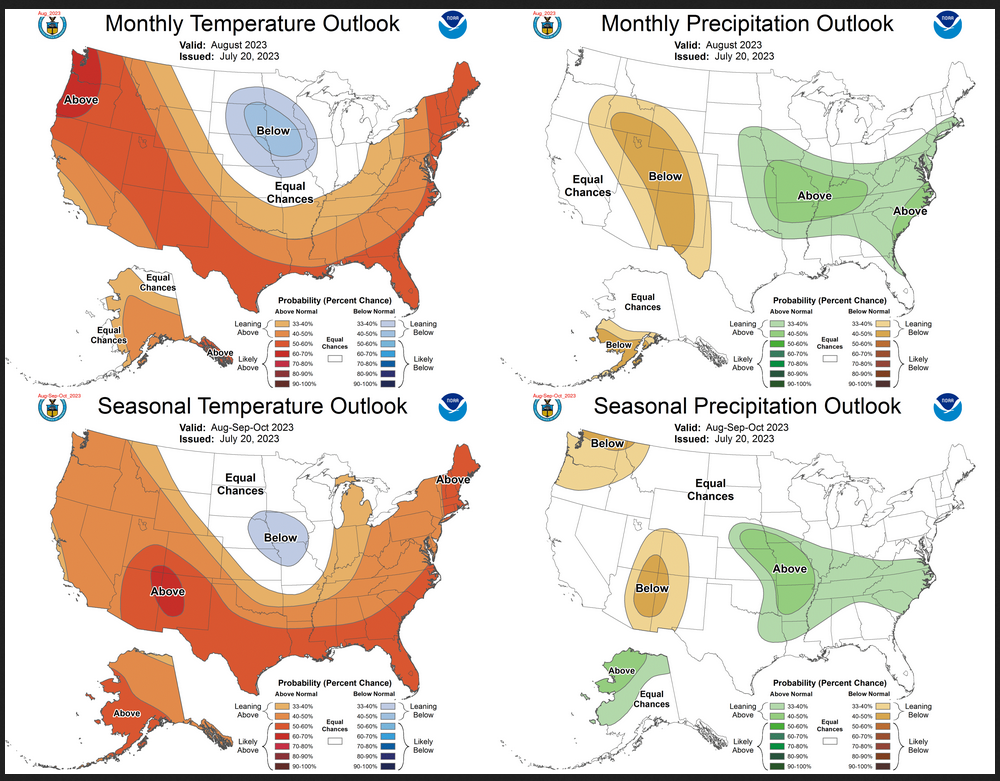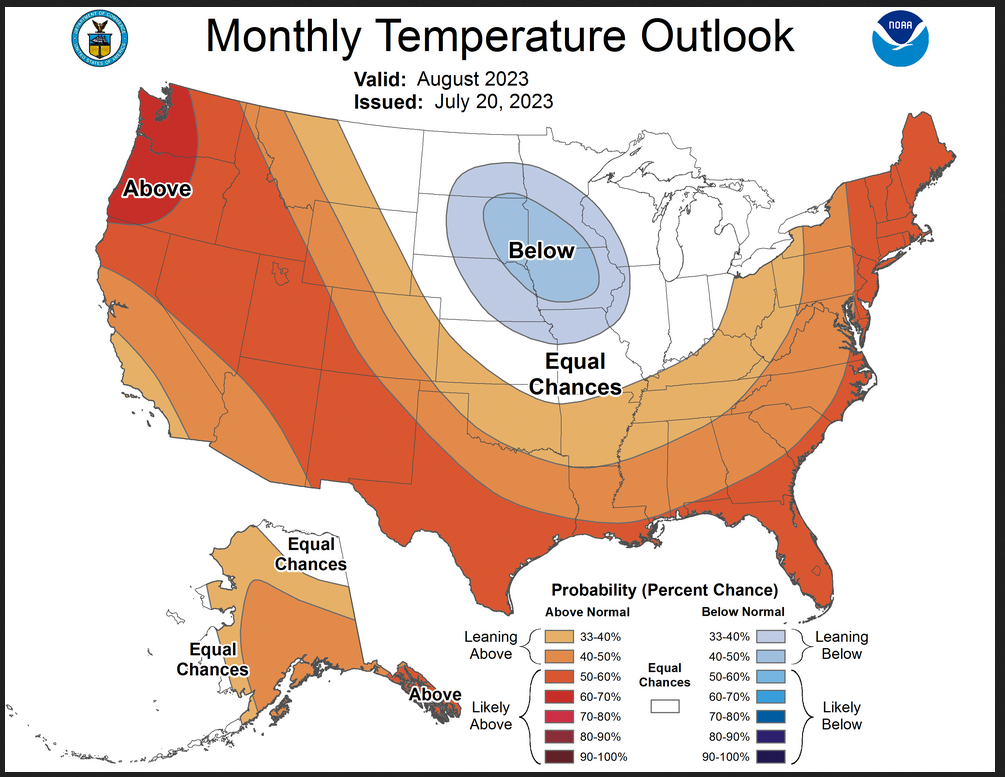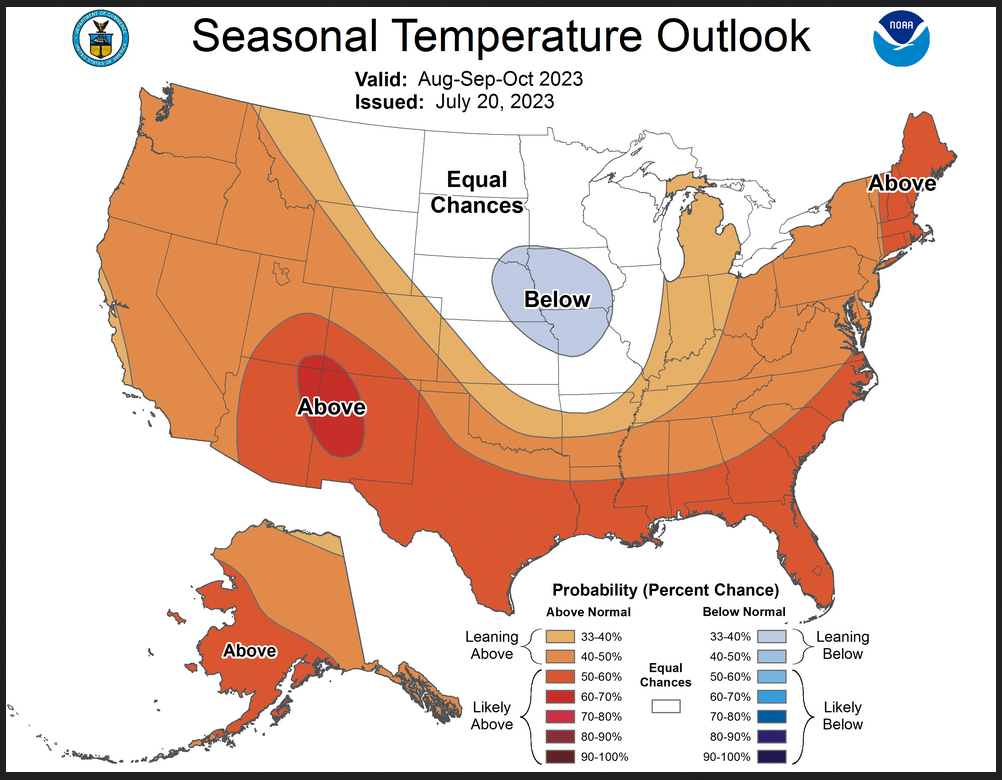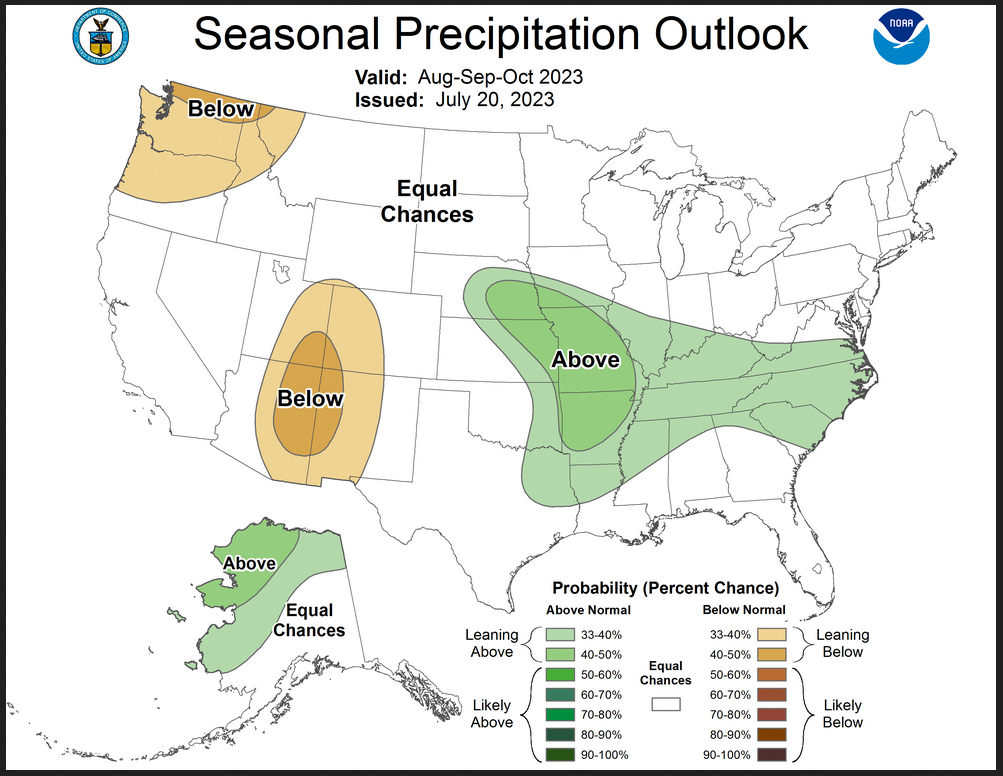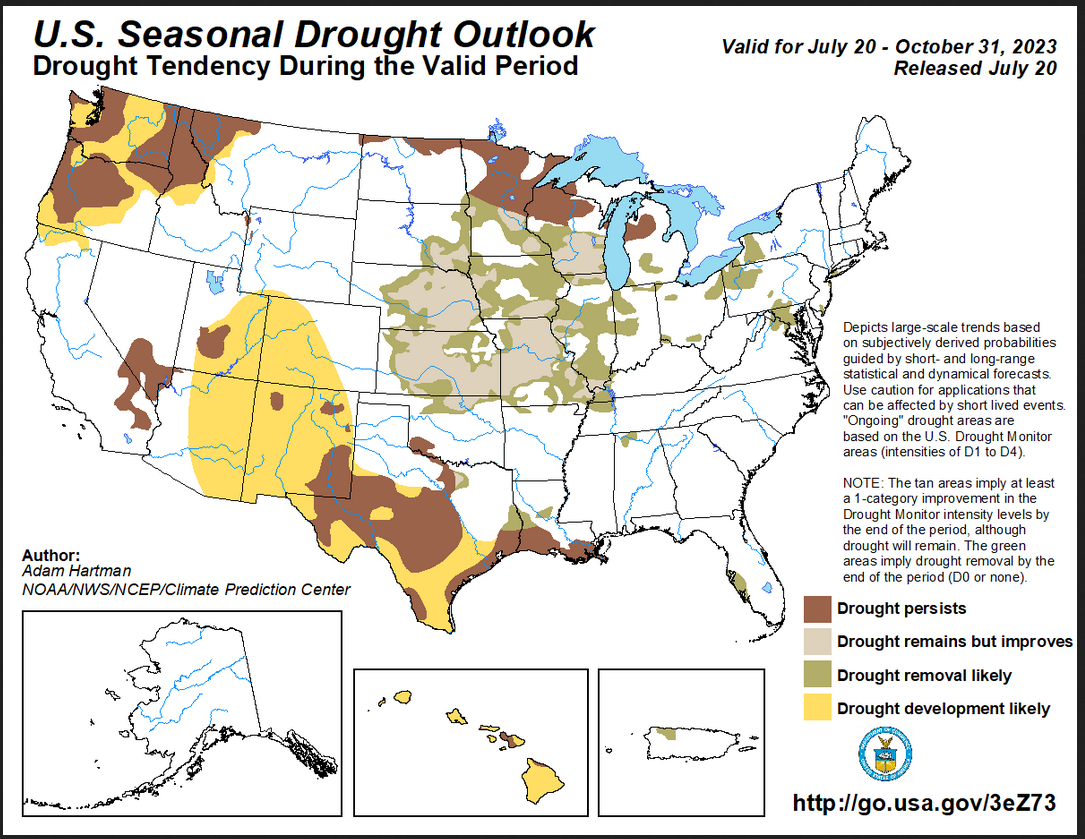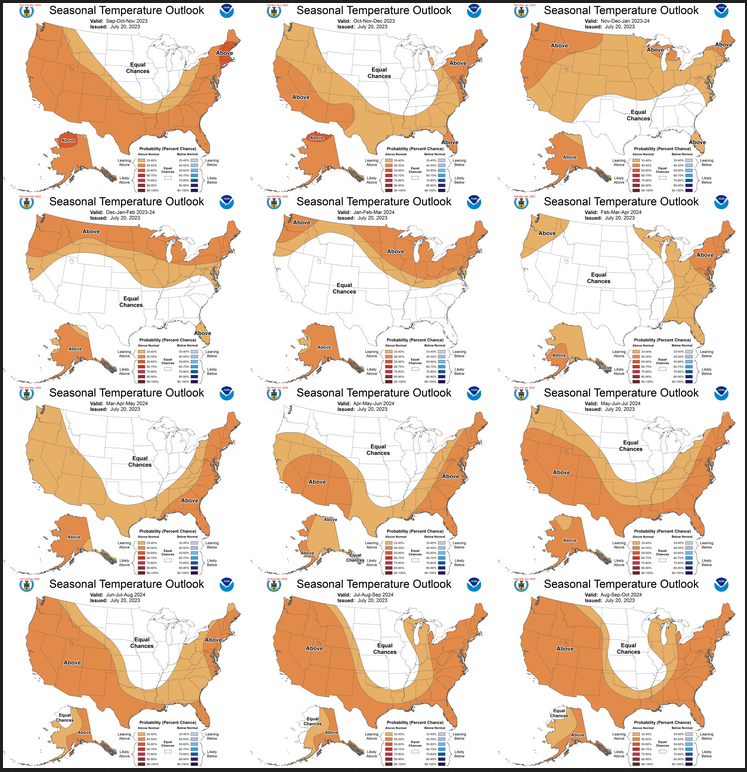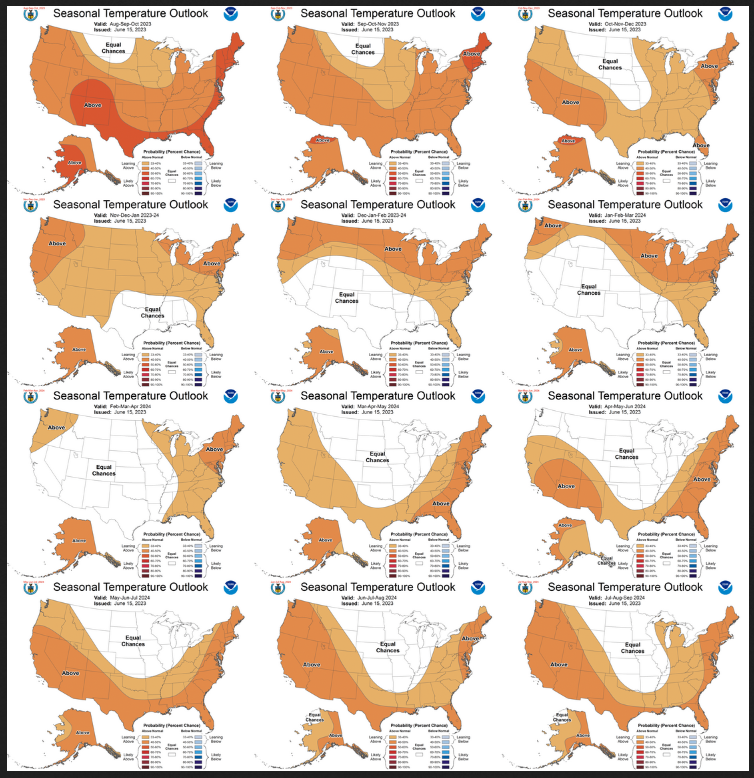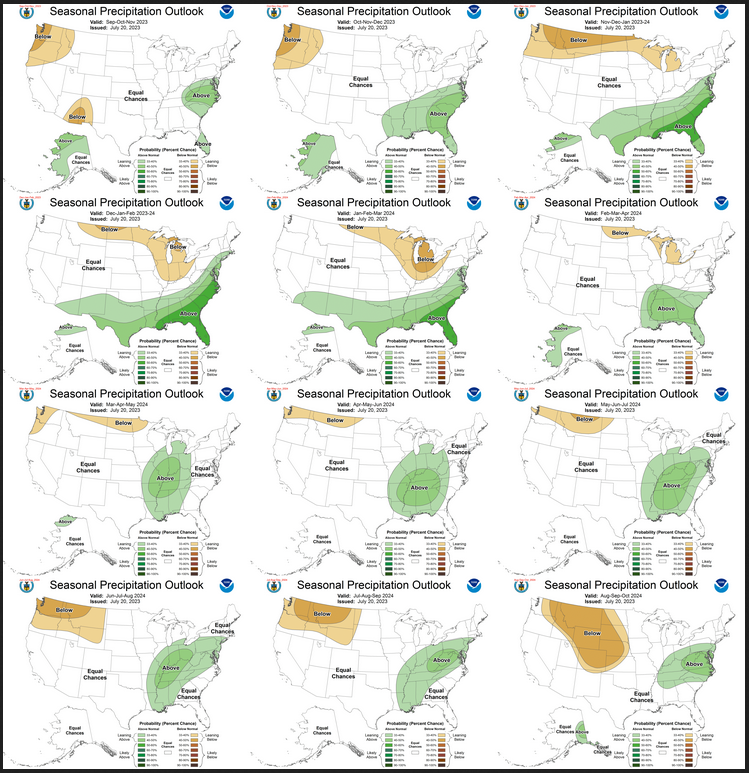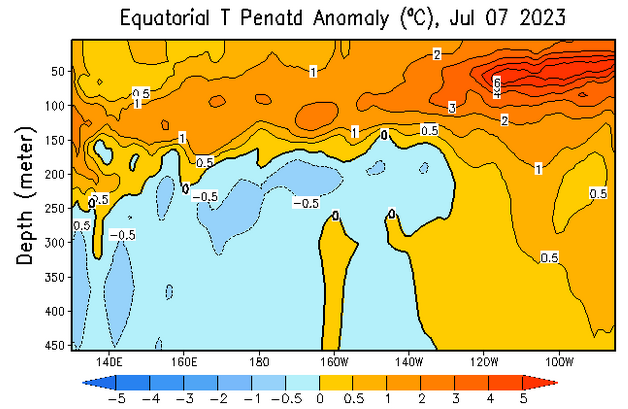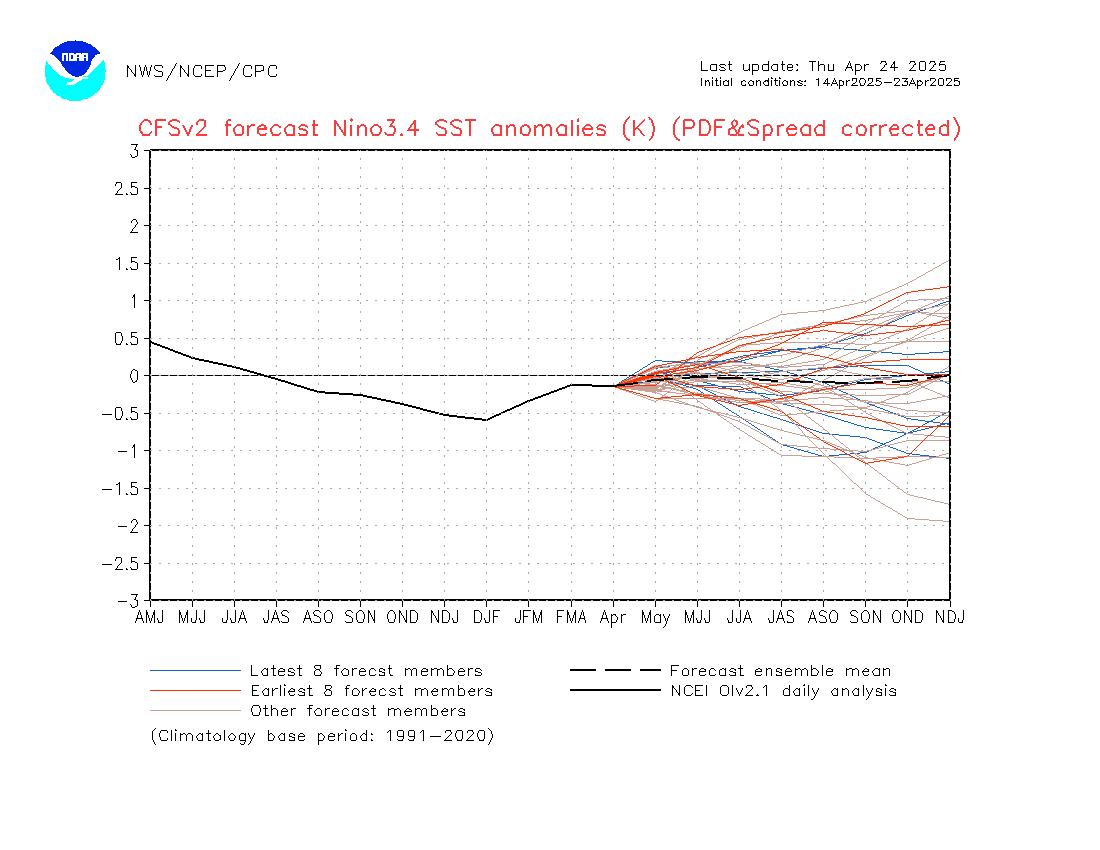On the third Thursday of the month right on schedule NOAA issued what I describe as their Four-Season Outlook. The information released also included the Mid-Month Outlook for the following month plus the weather and drought outlook for the next three months. I present the information issued by NOAA and try to add context to it. It is quite a challenge for NOAA to address the subsequent month, the subsequent three-month period as well as the twelve successive three-month periods for a year or a bit more. A seasonal drought outlook is also issued.
It is very useful to read the excellent discussion that NOAA issues with this Seasonal Outlook. The overall level of confidence in the Seasonal Outlook is addressed in the NOAA discussion. It is best to read the full discussion but here are some of the highlights:
Re ENSO:
- The observed weekly SSTs, centered on July 12, feature positive anomalies throughout the equatorial Pacific with the largest anomalies of more than +1 degree C generally east of 160°W.
- The CFSv2 continues to depict a strong El Niño by ASO, while the North American Multi-Model Ensemble (NMME) mean keeps the anomalies below 1.5 degrees C. The statistical tools vary with the strength of the El Niño during the next six months. As of early July, NOAA’s CPC forecast calls for more than a 90 percent chance of El Niño persisting through JFM 2024 with a 52 percent chance of a strong El Niño (> 1.5 degrees C) during OND 2023.
For August
- The August temperature outlook favors above normal temperatures over much of Alaska, consistent with dynamical model guidance and the monthly temperature consolidation.
- Widespread above normal temperatures are favored over much of the contiguous U.S. (CONUS), supported by the consolidation of statistical and dynamical forecast tools. Probabilities for above normal temperatures exceed 60 percent over the Pacific Northwest, due to dynamical model forecasts and dry soil moisture anomalies.
- Below normal temperatures are favored for parts of the eastern Northern Plains and upper Mississippi Valley.
- El Niño impacts favor potential troughing over the eastern central CONUS with northerly flow into this region.
- Statistical forecasts based on the current state of ENSO predict a larger area of favored below normal temperatures, resulting in a reduction in probabilities of above normal temperatures for much of the east-central CONUS.
- Above average SST anomalies along the Gulf and East Coasts increase the probability of above normal temperatures in these regions.
- The August precipitation outlook favors below normal precipitation near the coast of the southwestern Alaska Mainland.
- Though above normal precipitation is slightly favored in southwestern Arizona at the start of the month by the Week 3-4 Outlook, El Niño impacts and statistical forecast tools favor a suppressed monsoon for the full month of August.
- Below normal precipitation is favored for much of the Southwest Monsoon region from West Texas to northeastern Arizona and northward across the Intermountain West into parts of eastern Oregon and southern Idaho.
- Above normal precipitation is favored from eastern areas of the Central Plains across the central Mississippi Valley to the Atlantic Coast, along a preferred potential storm track and supported by the consolidation of precipitation forecast tools.
- Above normal precipitation is favored from northeastern Florida along the Atlantic Coast into southern New England, supported by the consolidation.
For ASO 2023:
- The August-September-October (ASO) 2023 temperature outlook favors above-normal seasonal mean temperatures across a majority of the U.S.
- The highest probabilities (more than 60 percent) of above-normal temperatures are forecast across parts of the Southwest.
- The ASO precipitation outlook depicts elevated probabilities of below-normal precipitation for parts of the Southwest and Pacific Northwest,
- while above-normal precipitation is favored across much of the central and southern Great Plains, parts of the Middle to Lower Mississippi Valley, the Tennessee Valley, and the central Atlantic Coast from the Carolinas to southern Virginia.
- Equal chances (EC) are forecast in areas where the likelihood of seasonal mean temperatures or seasonal accumulated precipitation amounts are expected to be similar to climatological probabilities.
Beyond ASO 2023:
- Beginning in NDJ 2023-24 through JFM 2024, predicted El Niño conditions result in enhanced chances for above-normal temperatures across the northern tier of the CONUS with an increasing coverage of EC across California, the Southwest, Southern Great Plains, and Lower Mississippi Valley.
- During the winter 2023-24, above-normal temperatures are favored across the East based on the statistical consolidation.
- From MAM to ASO 2024, the temperature outlook is consistent with decadal trends.
- The [precipitation] outlook for SON maintains most of those signals , except for the signal in the Plains as SON are not the core monsoon months.
- During OND the area where above-normal precipitation is favored expands from the Southeast to the Southern Plains, associated with likely impacts from the predicted states of ENSO. Correspondingly odds for below-normal precipitation expand in the Northwest.
- During NDJ 2023 to JFM 2024, the outlooks largely favor above-normal precipitation across the southern tier and below-normal precipitation across the northern tier of the CONUS. That pattern is largely aligned with ENSO impacts and model guidance.
- From FMA 2024 through ASO 2024, the outlooks primarily reflect the consolidation of available tools, which largely follows trends and ENSO impacts.

Let’s Take a Look at the Mid-Month Outlook for August.
Combination Mid-Month Outlook for next month (August) and the Three-Month Outlook
The top row is what is now called the Mid-Month Outlook for next month which will be updated at the end of this month. There is a temperature map and a precipitation map. The second row is a three-month outlook that includes next month. I think the outlook maps are self-explanatory. What is important to remember is that they show deviations from the current definition of normal which is the period 1991 through 2020. So this is not a forecast of the absolute value of temperature or precipitation but the change from what is defined as normal or to use the technical term “climatology”.
| Notice that the outlook for next month and the three-month outlooks are somewhat different with respect to temperature. This always raises the question of what will month two and month three look like. |
| For both temperature and precipitation, if you assume the colors in the maps are assigned correctly, it is a simple algebra equation to solve the month two/three anomaly probability for a given location = (3XThree-Month Probability – Month One Probability)/2*. So you can derive the month two/three outlook this way. You can do that calculation easily for where you live or for the entire map. |
| The current weather report is always available at econcurrents.com To return to this article, hit the return arrow in the upper left-hand corner of your screen. |
Here are larger versions of the Temperature and Precipitation Outlook maps for next month.
The maps are pretty clear in terms of the outlook.
And here are large versions of the three-month JAS 2023 Outlook
First temperature followed by precipitation.
| These maps are larger versions of what was shown earlier. The JAS precipitation pattern is classic for a weak Southwest Monsoon. The drivers of a weak Monson or delayed Monsoon at least early on benefit the area shown in the Great Plains as wetter than normal. The reverse tends to happen with a strong Southwest Monsoon. |
Drought Outlook
| The yellow is the bad news and there is hardly any yellow showing. The area with drought deterioration is quite large. But there is a lot of improvement forecast for the corn and soybean belts. |
Short CPC Drought Discussion
Latest Seasonal Assessment – Leading up to the August-October (ASO) Seasonal Drought Outlook (SDO), drought has slowly expanded across the Pacific Northwest due to below normal precipitation on the heels of a below average 2022-2023 winter wet season. Drought also developed across portions of the Midwest and Great Lakes during the months of May and June. Some of the drought across the Midwest also expanded into portions of the Ohio Valley and Northeast during that time, but several areas have seen improvements in recent weeks due to multiple periods of heavy rainfall. Long-term drought over the Great Plains has been slowly improving the past few months, particularly across the western Great Plains, where many areas have received in excess of 1.5 times their normal precipitation. Parts of the Intermountain West have continued to see slow improvements to drought conditions since the start of 2023, aided by above normal winter snowpack, sporadic convection, and above normal streamflows helping to improve reservoir levels. The slow start to the North American Monsoon (NAM) season and recent excessive heat across the southwestern U.S. has resulted in topsoil moisture drying out across the Four Corners region. However, there are signs that the NAM is becoming more established.
During the ASO season, above normal temperatures and below normal precipitation are predominantly favored across portions of the western U.S., leading to drought persistence and expansion across the Pacific Northwest and Four Corners region. A weaker NAM circulation is favored to enhance the potential for development across the Four Corners. Central portions of the Intermountain West may be spared degradation, as those areas are still showing residual benefits from above normal winter snowpack leading up to the summer, in addition to periods of above normal rainfall during the last 60 to 90 days. Seasonal temperature and precipitation outlooks, ENSO, and climatology favor widespread drought improvement and removal across the central U.S. However, drought persistence is favored across the Upper Midwest, although there is the potential for localized improvements. Extended-range temperature and precipitation outlooks favor drought development across parts of southern Texas, with long-range outlooks favoring persistence of existing drought. Widespread drought improvement and removal are favored across the eastern third of the U.S., where short and long-range precipitation outlooks favor near to above normal precipitation and warm sea surface temperatures in the Gulf of Mexico and western Atlantic will act to enhance the potential for daytime thunderstorm activity, especially over the next month.
Alaska is favored to remain drought-free through the end of October, as ASO is typically a wet time of year. Hawaii may see some short-term improvements to drought due to the passage of Tropical Storm Calvin on July 19th. However, long-range precipitation outlooks favor persistence and development (potentially redevelopment) of drought conditions. In Puerto Rico, the potential for tropical activity and favorable precipitation outlooks for August and the ASO season favor drought removal.
Looking out Four Seasons.
Twelve Temperature Maps. These are overlapping three-month maps (larger versions of these and other maps can be accessed HERE)
Notice that this presentation starts with August/September/October 2023 (ASO) since JAS is considered the near-term and is covered earlier in the presentation. The changes over time are generally discussed in the discussion but you can see the changes easier in the maps.
Comparing the new outlook with the prior Outlook,
The 12 temperature maps issued last month.
The easiest way to do the comparison is to print out both maps. If you have a color printer that is great but not needed. What I do is number the images from last month 1 – 12 starting with “1” and going left to right and then dropping down one row. Then for the new set of images, I number them 2 – 13. That is because one image from last month in the upper left is now discarded and a new image on the lower right is added. Once you get used to it, it is not difficult. In theory, the changes are discussed in the NOAA discussion but I usually find more changes. It is not necessarily important. I try to identify the changes but believe it would make this article overly long to enumerate them. The information is here for anyone who wishes to examine the changes. I comment below on some of the changes from the prior report by NOAA and important changes over time in the pattern.
| The only major change I saw was in the DJF 2023/2024 and JFM 2024 Temperature Outlooks. It is an interesting change in which the area that is not warmer than climatology is expanded. It is not surprising that NOAA has added more El Nino to the forecast this month as they gain confidence in the forecast for El Nino. |
Now the Twelve New Precipitation Maps
Similar to Temperature in terms of the organization of the twelve overlapping three-month outlooks.
Comparing the new outlook with the prior Outlook,
The maps that were released last month.
A good approach for doing this comparison is provided with the temperature discussion.
| Last month I was surprised that there were no major changes between the April and the May predictions. I assumed that such changes would happen this month and they did mostly for NDJ 2023/2024 through JFM 2024. They added more El Nino to the Outlooks. |
NOAA Discussion
Maps tell a story but to really understand what is going you need to read the discussion. I combine the 30-day discussion with the long-term discussion and rearrange it a bit and add a few additional titles (where they are not all caps the titles are my additions). Readers may also wish to take a look at the article we published last week on the NOAA ENSO forecast. That can be accessed here.
I will use bold type to highlight some things that are especially important. My comments, if any, are enclosed in brackets [ ].
CURRENT ATMOSPHERIC AND OCEANIC CONDITIONS
Oceanic and atmospheric observations across the equatorial Pacific reflect El Niño conditions. The observed weekly SSTs, centered on July 12, feature positive anomalies throughout the equatorial Pacific with the largest anomalies of more than +1 degree C generally east of 160°W. The largest anomalies are spreading westward along the equator. The latest weekly SST departure for the Niño 3.4 region is at +1.1 degrees C. Equatorial upper-ocean heat anomalies (averaged between 180 to 100 °W and 0-300m depth) remain strongly positive Low-level (850-hPa) wind anomalies during the last month were small in amplitude along the equator with a spatially small area of easterly anomalies along 5°S from 180 to 120°W. Consistent with El Niño conditions, negative OLR anomalies (enhanced convection) were located east of Papua New Guinea and also just north of the equator across the eastern Pacific. Those negative anomalies are further east compared to the last month. Positive OLR anomalies (suppressed convection) were observed throughout much of Southeast Asia and the Southwest Pacific.
The Real-time Multivariate (RMM) index depicts a weak Madden-Julian Oscillation (MJO) during early July. The 200-hPa velocity potential anomaly field features a coherent wave-1 structure, but it does appear to have influences from higher frequency modes. Dynamical model forecasts indicate that the MJO is likely to remain weak, and is not considered to be a factor in the earliest lead of the seasonal outlooks
Negative SST anomalies have persisted in the Chukchi Sea, while SSTs in the Bering Strait are above normal during the first half of July. Below-average SSTs are persistent in much of the Bering Sea and Gulf of Alaska and along much of the West Coast of the CONUS. The northern Gulf of Mexico warmed recently with above-normal SSTs observed during early July. Positive SST anomalies weakened across the eastern tropical Atlantic since May.
PROGNOSTIC DISCUSSION OF SST FORECASTS
The CPC SST Consolidation for the Niño 3.4 region indicates an increase in the magnitude of positive anomalies this summer and fall to around +1 degree C, followed by a decline to more neutral ENSO conditions during spring 2024. The CFSv2 continues to depict a strong El Niño by ASO, while the North American Multi-Model Ensemble (NMME) mean keeps the anomalies below 1.5 degrees C. The statistical tools vary with the strength of the El Niño during the next six months. As of early July, NOAA’s CPC forecast calls for more than a 90 percent chance of El Niño persisting through JFM 2024 with a 52 percent chance of a strong El Niño (> 1.5 degrees C) during OND 2023.
30-DAY OUTLOOK DISCUSSION FOR AUGUST 2023
The monthly temperature and precipitation outlooks are made under strengthening El Niño climate conditions. The recent week Niño 3.4 sea surface temperature (SST) anomaly is greater than +1.2 degrees Celsius. SSTs across the central and eastern equatorial Pacific Ocean have increased significantly over the last month. Lower level winds at 850 hPa are near average across much of the equatorial Pacific Ocean, except for weak easterly anomalies over parts of the east-central Pacific Ocean. Negative outgoing longwave radiation (OLR) anomalies are present just west of the Date Line, indicating anomalously enhanced convection. These ocean and atmosphere conditions indicate that the ongoing El Niño is strengthening. While it is expected that teleconnections between the tropics and the climate over North America will take time to be established, El Niño may impact temperature and precipitation patterns in the near future and plays a role in the August temperature and precipitation outlooks. The Madden Julian Oscillation (MJO) was disorganized during the last month, though dynamical models indicate that the MJO may become active over the Maritime Continent and propagate across the western Pacific in the next few weeks. However, the MJO forecast appears somewhat uncertain at this time and was not used as a significant factor in the August monthly outlook.
Temperature
The August temperature and precipitation outlooks were primarily based on a skill-weighted consolidation of statistical and dynamical forecast tools. The full consolidation includes a consolidation of recent dynamical model forecasts from the North America Multimodel Ensemble (NMME) for the month of August. In addition, the full consolidation includes a consolidation of the Canonical Correlation Analysis (CCA), the Constructed Analog (CA), and an ENSO OCN tool, that combines the impact of ENSO, based on the forecasts of Niño 3.4 SST anomaly, with the Optimum Climate Normal (OCN) representation of decadal trends. Daily initialized forecasts from the NCEP CFSv2 dynamical model, the most recent CPC Week 3-4 Outlook that overlaps the beginning of the month of August, and a statistical multivariate linear regression (MLR) forecast for the first half of August using the current Niño 3.4 and MJO indices as predictors, were also considered. Recent boundary conditions, including near coastal SSTs and soil moisture anomalies, were additional factors considered.
The August temperature outlook favors above normal temperatures over much of Alaska, consistent with dynamical model guidance and the monthly temperature consolidation. Forecasts of equal chances (EC) of above, near and below normal temperatures are indicated for the west coast of Alaska, where below average SSTs should moderate air temperatures. Equal chances (EC) is also forecast for the northeast Mainland, where tools are inconsistent. Widespread above normal temperatures are favored over much of the contiguous U.S. (CONUS), supported by the consolidation of statistical and dynamical forecast tools. Probabilities for above normal temperatures exceed 60 percent over the Pacific Northwest, due to dynamical model forecasts and dry soil moisture anomalies. Below normal temperatures are favored for parts of the eastern Northern Plains and upper Mississippi Valley. El Niño impacts favor potential troughing over the eastern central CONUS with northerly flow into this region. Statistical forecasts based on the current state of ENSO predict a larger area of favored below normal temperatures, resulting in a reduction in probabilities of above normal temperatures for much of the east-central CONUS. Above average SST anomalies along the Gulf and East Coasts increase the probability of above normal temperatures in these regions.
Precipitation
The August precipitation outlook favors below normal precipitation near the coast of the southwestern Alaska Mainland, supported primarily by dynamical model forecasts from the NMME and the consolidation of precipitation forecast tools. Though above normal precipitation is slightly favored in southwestern Arizona at the start of the month by the Week 3-4 Outlook, El Niño impacts and statistical forecast tools favor a suppressed monsoon for the full month of August. Below normal precipitation is favored for much of the Southwest Monsoon region from West Texas to northeastern Arizona and northward across the Intermountain West into parts of eastern Oregon and southern Idaho. Above normal precipitation is favored from eastern areas of the Central Plains across the central Mississippi Valley to the Atlantic Coast, along a preferred potential storm track and supported by the consolidation of precipitation forecast tools. Above normal precipitation is favored from northeastern Florida along the Atlantic Coast into southern New England, supported by the consolidation.
SUMMARY OF THE OUTLOOK FOR NON-TECHNICAL USERS (Focused on August-September and October 2023)
Temperature
The August-September-October (ASO) 2023 temperature outlook favors above-normal seasonal mean temperatures across a majority of the U.S. The highest probabilities (more than 60 percent) of above-normal temperatures are forecast across parts of the Southwest.
Precipitation
The ASO precipitation outlook depicts elevated probabilities of below-normal precipitation for parts of the Southwest and Pacific Northwest, while above-normal precipitation is favored across much of the central and southern Great Plains, parts of the Middle to Lower Mississippi Valley, the Tennessee Valley, and the central Atlantic Coast from the Carolinas to southern Virginia. Equal chances (EC) are forecast in areas where the likelihood of seasonal mean temperatures or seasonal accumulated precipitation amounts are expected to be similar to climatological probabilities.
El Niño conditions are present and equatorial sea surface temperatures (SSTs) are above average across the central and eastern equatorial Pacific Ocean. El Niño is expected to strengthen and persist through the winter 2023-24.
BASIS AND SUMMARY OF THE CURRENT LONG-LEAD OUTLOOKS
PROGNOSTIC TOOLS USED FOR U.S. TEMPERATURE AND PRECIPITATION OUTLOOKS
Tools used for the seasonal outlooks included dynamical model guidance such as the NMME, the Calibration, Bridging, and Merging (CBaM) post-processing of theNMME, and the Copernicus Climate Change Service (C3S) seasonal model contributions. In addition, the consolidation tool, which includes NMME input and various statistical tools were used. Current soil moisture conditions were a consideration across the Midwest and Corn Belt in the ASO temperature outlook. El Niño temperature and precipitation correlations were relied upon from ASO 2023 through FMA 2024 and these composites were weighed most heavily from NDJ 2023-24 through JFM 2024. Decadal trends in temperature and precipitation were a factor at all time leads but elied upon the most at the longer leads, when dynamical model guidance is not available
PROGNOSTIC DISCUSSION OF OUTLOOKS – ASO 2023 TO ASO 2024
TEMPERATURE
Above-normal temperatures are favored throughout a majority of the U.S. during ASO with the highest probabilities (above 60 percent) forecast for a portion of the Southwest. For much of the West, Gulf Coast, and East, probabilities are greater than 50 percent for above-normal temperatures, consistent with dynamical model guidance and decadal trends . CBaM, trends , and correlations with Nino 3.4 support favoring below-normal temperatures in the Central Plains. Many of the tools also indicate a weak monsoon, so probabilities for above-normal temperatures exceed 60 percent in the Four Corners region. Compared to the previous outlook, above-normal temperature probabilities were decreased across the Corn Belt and Great Lakes, consistent with correlations with a moderate El Niño and the latest NMME output. The consolidation tool and El Niño composites support above-normal temperature probabilities across much of Alaska. Above-normal temperatures remain the most likely outcome throughout much of the U.S. for SON and OND 2023, with Equal Chances over the Northern and Central Plains and the Upper Great Lakes. Beginning in NDJ 2023-24 through JFM 2024, predicted El Niño conditions result in enhanced chances for above-normal temperatures across the northern tier of the CONUS with an increasing coverage of EC across California, the Southwest, Southern Great Plains, and Lower Mississippi Valley. During the winter 2023-24, above-normal temperatures are favored across the East based on the statistical consolidation. From MAM to ASO 2024, the temperature outlook is consistent with decadal trends .
PRECIPITATION
During ASO 2023, below-normal precipitation is favored for the Pacific Northwest, though the signal is weaker than indicated last month for lead 2, as indicated by the latest NMME guidance and trends . Below-normal precipitation, associated with an anomalously weak monsoon and as indicated in the SST-CA, OCN, and NMME, is likely for the Southwest. Correspondingly, above-normal precipitation is likely over the Central and Southern Plains, as a dipole in precipitation between the Southwest and Plains is common during the summer months. Above-normal precipitation is weakly favored over the Southeast, on the southern flank of an anomalous trough, likely over the Great Lakes. Anomalous troughing in the Great Lakes is associated with El Niño and indicated in many of the NMME models. The outlook for SON maintains most of those signals , except for the signal in the Plains as SON are not the core monsoon months. During OND the area where above-normal precipitation is favored expands from the Southeast to the Southern Plains, associated with likely impacts from the predicted states of ENSO. Correspondingly odds for below-normal precipitation expand in the Northwest.
During NDJ 2023 to JFM 2024, the outlooks largely favor above-normal precipitation across the southern tier and below-normal precipitation across the northern tier of the CONUS. That pattern is largely aligned with ENSO impacts and model guidance. From FMA 2024 through ASO 2024, the outlooks primarily reflect the consolidation of available tools, which largely follows trends and ENSO impacts.
During ASO, trends and model guidance favor above-normal precipitation for western and northern mainland Alaska, consistent with ENSO impacts and ice edge retreat. Odds are mitigated by trends over western Alaska. During SON and OND, trends indicate a wet signal again, so coverage of above-normal precipitation is favored over a larger area. During winter 2023/2024, signals for precipitation in Alaska are weak, so much of the state has EC indicated, except the North Slope where trends favor above-normal precipitation.
Review of the ENSO Assumptions utilized by NOAA (CPC) in Preparing this Four-Season Outlook
The key information used by NOAA follows.
IRI CPC ENSO STATE Probability Distribution (IRI stands for the International Research Institute for Climate and Society)
Here are the new forecast probabilities. This information is released twice a month and the first release is based on a survey of Meteorologists, the second is based on model results. The probabilities are for three-month periods e.g. MAM stands for March/April/May. I am just showing the first release which is what we have and presumably what NOAA (actually their CPC Division) worked from.
| It looks like El Nino through the forecast period. |
Tropical Subsurface Temperature Anomalies
| You can update this graphic by clicking HERE and scrolling down to “Mean and anomalous equatorial temperatures“. One has to differentiate between the surface and at depth. Last month the surface still fit with ENSO Neutral but below the surface, there was a lot of anomalously warm water. Now the ocean clearly is consistent with El Nino and based on the new NOAA CPC Division Advisory, the atmosphere has confirmed that we are in El Nino. That is why this looks like a very sustainable El Nino. |
| The image will update if you click HERE. This model is predicting a fairly strong El Nino lasting a while. |
Resources
–
| I hope you found this article interesting and useful. |
–
